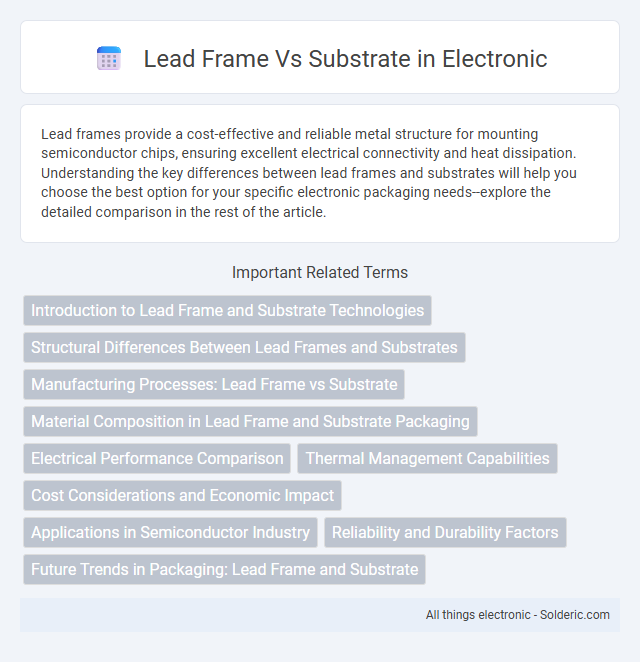Lead frames provide a cost-effective and reliable metal structure for mounting semiconductor chips, ensuring excellent electrical connectivity and heat dissipation. Understanding the key differences between lead frames and substrates will help you choose the best option for your specific electronic packaging needs--explore the detailed comparison in the rest of the article.
Comparison Table
| Feature | Lead Frame | Substrate |
|---|---|---|
| Material | Metal (Copper, Alloy) | Multi-layer PCB or Ceramic |
| Function | Electrical connection & mechanical support | Electrical interconnection & heat dissipation |
| Cost | Lower cost | Higher cost |
| Thermal Management | Moderate heat conduction | Superior heat dissipation |
| Application | Discrete IC packaging | High-performance, multi-chip modules |
| Complexity | Simple structure | Complex multilayer design |
| Size | Relatively larger | Compact, supports miniaturization |
| Reliability | Good for general use | Enhanced for harsh environments |
Introduction to Lead Frame and Substrate Technologies
Lead frame and substrate technologies serve as essential components in semiconductor packaging, with lead frames providing a metal framework for chip support and electrical connectivity, while substrates offer multilayered electrical interconnections and mechanical stability. Lead frames are typically made from materials like copper or alloy 42 and are favored for cost-effectiveness and simplicity in traditional packaging like DIP and QFP. Substrates, often composed of organic materials such as BT resin or ceramic, support advanced packaging with higher I/O density and improved thermal and electrical performance in applications like BGA and CSP packages.
Structural Differences Between Lead Frames and Substrates
Lead frames consist of metal strips that mechanically support and electrically connect semiconductor chips, typically made from copper or alloy metals with a simple planar structure. Substrates are multi-layered, composite materials combining organic, ceramic, or glass layers with embedded copper circuits, enabling complex routing and higher density interconnections. Your choice between lead frames and substrates depends on the required electrical performance, thermal management, and package complexity.
Manufacturing Processes: Lead Frame vs Substrate
Lead frame manufacturing involves stamping or etching metal sheets, typically copper or alloy, followed by plating and molding processes that secure the semiconductor die; this method emphasizes cost-effectiveness and high-volume production. Substrate manufacturing requires multilayer substrate fabrication using materials like BT resin or ceramics, involving complex layering, via drilling, and metallization steps for advanced electrical performance and miniaturization. Your choice between lead frame and substrate depends on the required electrical properties, thermal management, and production scale.
Material Composition in Lead Frame and Substrate Packaging
Lead frame packaging primarily uses metal alloys such as copper or iron-nickel, offering excellent electrical conductivity and mechanical strength for semiconductor mounting. Substrate packaging features multi-layered materials including ceramics, organic laminates, or resin-based composites to support complex circuitry and provide superior heat dissipation. Understanding the material composition in your chosen package impacts thermal management, electrical performance, and overall device reliability.
Electrical Performance Comparison
Lead frames offer lower electrical resistance and inductance, making them ideal for high-frequency and high-current applications. Substrates provide better thermal conductivity and support complex multilayer routing, enhancing signal integrity and reducing crosstalk in advanced semiconductor devices. Your choice between lead frame and substrate impacts electrical performance based on the specific requirements of efficiency, frequency range, and thermal management.
Thermal Management Capabilities
Lead frames offer moderate thermal management capabilities by directly dissipating heat through metal strips, ideal for low to mid-power applications. Substrates provide superior thermal conductivity with multi-layer designs incorporating materials like ceramic or metal, enabling efficient heat spreading for high-power and high-density electronic devices. Evaluating your thermal management needs depends on balancing cost, performance, and application-specific heat dissipation requirements.
Cost Considerations and Economic Impact
Lead frames offer a cost-effective solution due to lower material and manufacturing expenses, making them ideal for high-volume, low-cost semiconductor packaging. Substrates, however, incur higher costs because of advanced materials and complex fabrication processes, but they provide enhanced performance and reliability for premium applications. The economic impact favors lead frames in mass production environments, while substrates justify their price through improved device performance and long-term value.
Applications in Semiconductor Industry
Lead frames are primarily used in traditional semiconductor packaging for integrated circuits, offering reliable electrical connections and efficient heat dissipation in applications like microcontrollers and power devices. Substrates, with their multilayer and high-density interconnect capabilities, are favored in advanced applications such as system-in-package (SiP) and high-frequency RF modules. Your choice between lead frame and substrate depends on factors like device complexity, thermal management needs, and miniaturization requirements in semiconductor manufacturing.
Reliability and Durability Factors
Lead frames exhibit high mechanical strength and excellent thermal conductivity, enhancing reliability in power and high-frequency applications, while substrates offer superior electrical insulation and flexibility for complex, multi-layer circuit designs. Substrate materials, such as BT resin or ceramic, provide better moisture resistance and reduce warpage, significantly improving long-term durability under harsh environmental conditions. The choice between lead frame and substrate impacts reliability due to differences in thermal expansion coefficients, with substrates generally offering better performance in minimizing stress and fatigue during thermal cycling.
Future Trends in Packaging: Lead Frame and Substrate
Future trends in packaging highlight a shift towards substrate materials due to their superior electrical performance and thermal management capabilities compared to traditional lead frames. Advanced substrate technologies enable higher integration densities and support miniaturization critical for 5G and AI applications. Innovations in lead frame materials are focusing on cost reduction and enhanced heat dissipation to remain competitive in emerging markets.
Lead Frame vs Substrate Infographic

 solderic.com
solderic.com